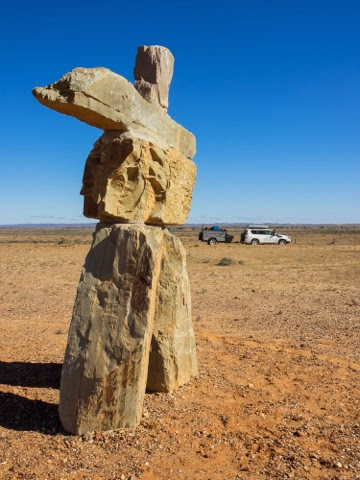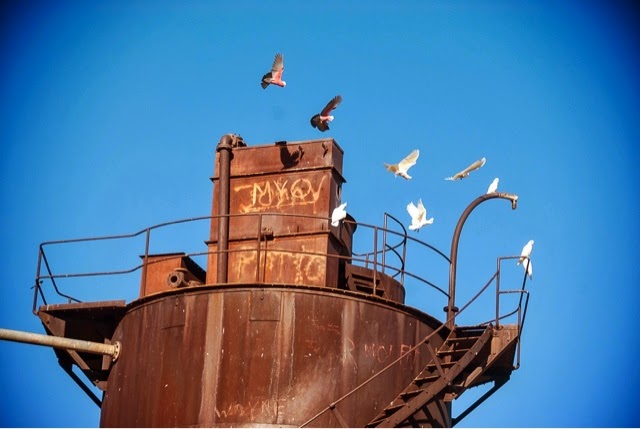Day 10: What was that hissing sound?
Yesterday I noticed a chunk out of the side wall of the front tyre. While it was still OK I didn't like the idea of a blow out half way in the middle of know where. So out with the spare tyre and tools, wheel off, and a quick change on the side of the road. Will this be the only one for the whole trip?
Setting off on the next leg of the "Ood" - as the locals call it - we trundled along the red rumbling track.
There are many strange things you see out here, some of them not because of the delerium from the heat. Somewhere between hump number 125 and dry river crossing 59 you come across 2 metal planes side by side and nose pointing skyward like they are holding hands. This is one of about 20 strange sculptures that appears in the flat gibber plains.
Further on, out to east, a shimmering mirage glistened over the white encrusted Lake Eyre South. But on closer inspection parts of Lake had the remnants of water which could have originated many months ago in far flung Queensland.
Early explorers looking for the inland sea were disappointed when they found this dry lake. However at the time they didn't realise that they actually had found it. Unfortunately for them it was located under their feet as the Great Artesian Basin. While the landscape is generally dry, the water manages to squeeze it self to the surface in various places creating unique natural springs.
The path we followed today has been a travel path for the Kuyani, Arabana and Antikirimya people long before us as they followed the springs. The springs also allowed the early explorers such as John McDouall Staurt, who made the first crossing of the Austrialian interior. We stopped at Blanche Cup Springs, a water pool sitting atop a mound that has grown over the eons as a result of mineral deposits being brought to the surface with the ancient water.
Further along Coward Springs has had the added feature of a small pool being constructed for weary travellers to wash of the dust.
These water oasis in the desert are also the reason for the old Ghan line to follow the same path. The water, essential for the early steam trains that ventured up the line bringing much needed supplies to these remote communities. What remains is a unique collection of stone sidings and rusty red water towers. This included Beresford and Curdimurka with their buckled timber verandas and corroding iron roofs that are a welcome diversion in an otherwise barren plain.
Now back to that issue of the tyre. Travelling along the track I made a comment on the number of tyre carcasses I had seen on the side of the road. All of a sudden there was a loud twang then a strange hissing sound outside. Either I had managed to run over a large snake that was now very angry or I had got my first puncture. Pulling over the good news it was not a snake. The bad news, the tyre was now resembling a flat panckake. So the next question was - did I pay attention to that lesson on using a tyre plug when we did the 4WD training?
Luckily it was not in the side wall, so out with the tools, lift the car (twice - damn those small jacks)' wheel off, pump tyre, clean hole, place plug in hole, re inflate tyre, place back on car. Good to go. Note: this takes much longer than it sounds.
Another long day on the road but we had one more stop and that was a quick beer at William Creek. Better known as being the 'pub in the middle of knowhere' this iconic outback pub is a welcome rest stop for a thirsty traveller - and Jay gets VERY thirsty!
The end of another day and campfire on the banks of a remote creek. Let's hope we have no more practice at changing tyres.
.

















0 comments: